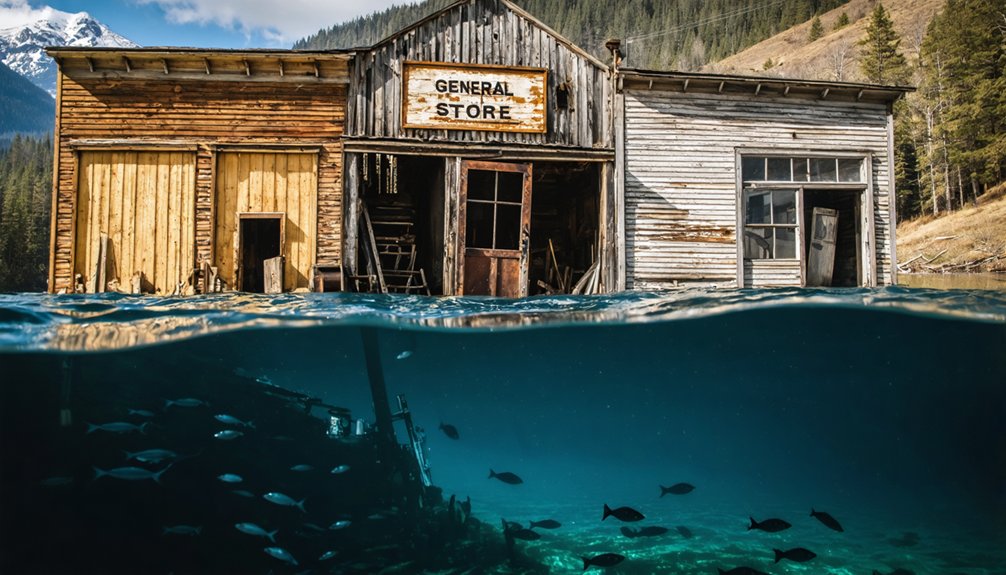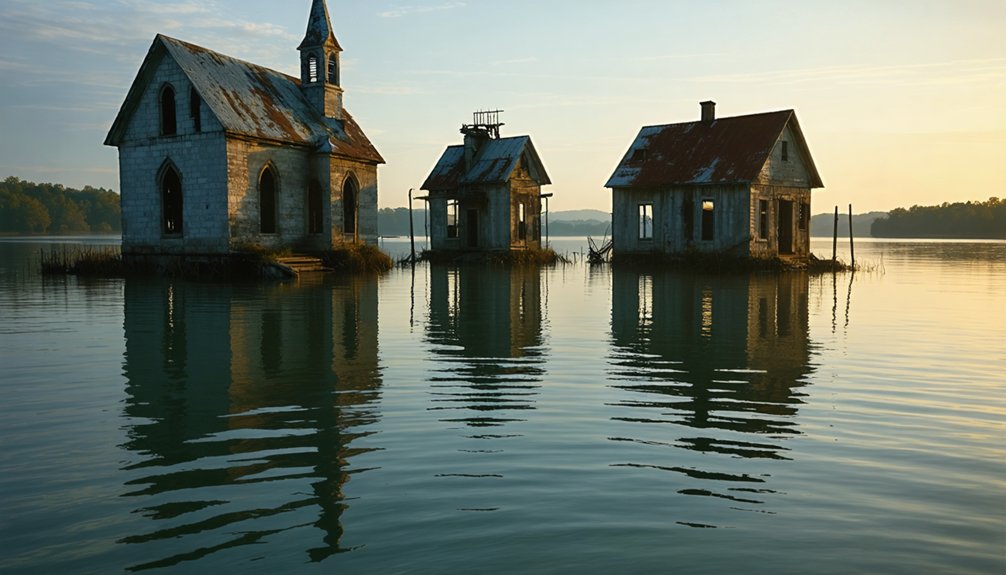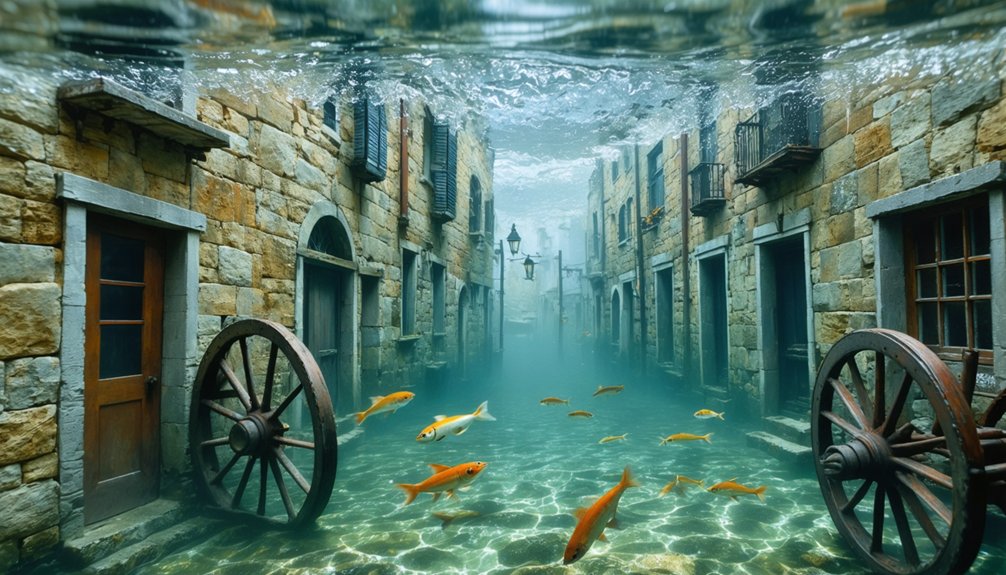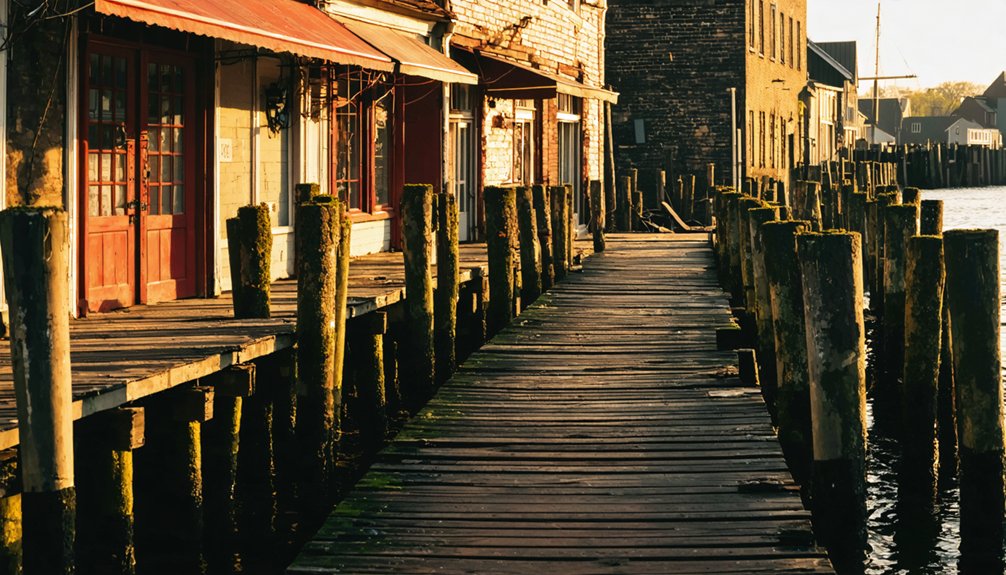To safely explore flooded American River ghost towns, you’ll need to research historical water patterns, pack waterproof safety equipment, and consult local experts for hidden locations. Document findings without disturbing sites, time visits during late summer for ideal exposure, prepare for underwater photography’s unique challenges, and practice strict leave-no-trace ethics. These submerged settlements offer fascinating glimpses into California’s past if you approach them with proper preparation and respect.
Key Takeaways
- Monitor reservoir levels and drought patterns for ideal exploration timing during late summer and early fall.
- Pack waterproof documentation tools, offline maps, and establish multiple emergency extraction routes.
- Practice proper underwater ethics by maintaining neutral buoyancy and avoiding contact with fragile structures.
- Consult local historians and archaeologists before visiting to understand site-specific challenges and legal requirements.
- Prepare for rapidly changing conditions by monitoring weather forecasts and establishing clear emergency communication protocols.
Research Historical Water Patterns Before You Go
Before commencing your exploration of American River ghost towns, you must understand the complex hydrological history that shaped—and ultimately submerged—these settlements.
The region’s historical hydrology reveals a pattern of mega-floods recurring every 100-200 years, with catastrophic events like the 1862 flood that lasted 43 days transforming entire landscapes.
Study the watershed’s unique characteristics—Sierra Nevada runoff reaches the valley floor rapidly, intensifying flood impact.
Atmospheric rivers, narrow bands of moisture from the Pacific, drove major historical floods including the 1861-62 disaster. These events prompted significant modifications: straightened river courses, elevated city streets, and dam construction.
Early settlers often underestimated flooding risks despite Native American warnings about seasonal inundation of the valley.
The Sacramento and American Rivers junction became particularly vulnerable during the Great Flood, with water levels rising to 22 feet above the low water mark.
Reviewing hydrological data and paleoflood analyses will help you identify likely locations of submerged settlements and understand how river hydraulics have altered these once-thriving communities.
Your exploration of flooded ghost towns requires waterproof documentation tools such as sealed notebooks, submersible cameras, and laminated historical reference materials to preserve your findings and contextual data despite wet conditions.
Create detailed emergency extraction plans identifying multiple escape routes from each exploration site, accounting for potential rising water levels and changing conditions that might compromise your primary exit strategy.
These plans should include predetermined rally points, vehicle staging locations, and communication protocols that enable swift evacuation if weather deteriorates or equipment fails. Consider bringing a small aluminum johnboat for accessing difficult areas safely when water levels fluctuate unexpectedly. Download offline maps for reliable navigation when cellular service is unavailable in remote ghost town locations.
Waterproof Documentation Tools
Exploring flooded ghost towns requires three categories of essential waterproof documentation tools to guarantee both safety and preservation of historical findings.
First, invest in high-quality waterproof bags utilizing multi-layered protection with aluminum-based fiberglass and silicone-coated materials that shield your documents from both water damage and high temperatures.
Second, consider water-resistant safes with rubber seals that can withstand submersion in 8-10 inches of water for at least 24 hours, ensuring document safety during unexpected flooding.
Finally, digitize all critical records before exploration, creating ultimate protection against physical destruction. These secure digital copies allow you to retrieve your valuable documentation from anywhere if physical records become damaged.
For maximum preservation capabilities, select containers explicitly rated for water protection when storing insurance policies and legal documents. Include a battery-powered radio to receive emergency updates about changing water levels during your exploration.
Mid-range waterproof safes offer extended protection for up to 72 hours submerged, accommodating larger document collections and valuable artifacts recovered during your explorations.
Emergency Extraction Plans
When venturing into flooded ghost towns along American rivers, thorough emergency extraction plans must be established to mitigate the significant risks associated with rapidly changing water conditions.
Before departure, identify multiple extraction points along your route where emergency contacts can reach you if standard evacuation becomes impossible. Pre-coordinate with local authorities and share your detailed itinerary with reliable individuals. Memorize extraction techniques appropriate for various scenarios—throw ropes for water rescues and established high-ground meeting points for group separations.
Always carry waterproof maps marking these extraction zones and maintain communication devices like satellite messengers or waterproof radios. Your group should practice emergency signals and establish clear roles for crisis situations. Some locations like St. Thomas ruins become accessible only during specific drought conditions when Lake Mead’s water levels drop significantly. Be especially cautious around river areas with potential underwater hazards, as debris removal operations may be ongoing at historic collapse sites.
Remember that extraction plans must account for potential changes in water levels and submerged obstacles that might suddenly block planned escape routes.
Consult Local Experts for Hidden Locations
Why do serious explorers turn to local experts when seeking America’s submerged ghost towns? Their specialized local knowledge reveals access to sites that remain invisible to casual visitors, providing critical safety insights and historical context that transform simple sightseeing into meaningful exploration.
These experts employ sophisticated methodologies—combining archival research, field reconnaissance, and oral histories—to map submerged settlements with precision.
Their expert insights help you navigate complex river hydrology while identifying well-preserved structures beneath the water’s surface. When you collaborate with regional historians, you’ll receive practical guidance on gear requirements, launch points, and legal permissions necessary to access protected sites. These historians can also direct you to nearby attractions like Bodie State Park, where buildings are preserved exactly as they were left during the mining era. For example, to see Ferguson, South Carolina, visitors must kayak from Lake Marion to view the remaining structures of this once-thriving lumber town now underwater.
Document Your Findings Without Disturbing Sites
Successful documentation of submerged ghost towns requires meticulous non-invasive techniques that preserve site integrity while creating extensive records for posterity.
Employ high-resolution underwater photography and aerial imaging to capture structural details without physical contact. When direct access threatens site stability, utilize ROVs to navigate safely around fragile remains.
Preserve our submerged history through non-contact documentation techniques, deploying remote technology where human presence risks deterioration.
Digital modeling through 3D photogrammetry transforms your photographs into detailed spatial records while respecting preservation laws.
Remember to log all findings with GPS coordinates and environmental conditions in standardized formats. Coordinate with archaeologists to confirm your documentation contributes to scholarly understanding of these sites.
Always comply with regulations protecting submerged cultural resources and obtain necessary permits before exploration.
Time Your Visit During Optimal Water Conditions

Timing your exploration strategically determines the success of your underwater ghost town adventure. Plan visits during late summer and early fall when reservoirs reach their lowest levels, offering extended access to normally submerged sites.
Track historical water level data for your target location to identify recurring patterns that predict ideal exposure windows. Monitor seasonal precipitation forecasts and El Niño predictions, as a single wet winter can quickly resubmerge sites that drought has revealed.
The cyclical nature of California’s drought patterns means decades might pass between ideal timing opportunities, especially following major flood events like those documented on the American River in 1850, 1907, and 1950.
Weather forecasting provides vital advance notice of changing conditions. Follow local water authority announcements about reservoir management to maximize your exploration window during these increasingly unpredictable climate cycles.
Prepare for Underwater Photography Challenges
Capturing images beneath murky waters presents unique technical hurdles beyond conventional landscape photography.
River ghost towns demand specialized equipment and techniques to document their submerged history. Visibility rarely exceeds one meter, requiring advanced lighting techniques and careful equipment maintenance to prevent failure in silty conditions.
To overcome these challenges:
- Set up external lighting systems at 45-degree angles to minimize backscatter from suspended particles
- Shoot in RAW format with manual focus to compensate for murky conditions
- Plan dives during early morning hours when water movement is minimal
- Apply anti-fog solutions to lenses and check O-ring seals before each dive
Remember that documenting these underwater time capsules requires patience and technical precision, but yields irreplaceable historical records of America’s submerged past.
Practice Leave-No-Trace Exploration Ethics

When exploring submerged ghost towns, you’ll need to maintain pristine underwater environments by swimming carefully above structures without stirring sediment or touching fragile remains.
Document your discoveries through photography rather than collecting artifacts, preserving these historical treasures for future generations and scientific study.
Remember to carry out all equipment, waste, and materials you bring, leaving no trace of your visit in these unique underwater cultural landscapes.
Minimize Underwater Disturbance
Although exploring submerged ghost towns offers a fascinating glimpse into America’s flooded past, responsible visitors must adhere to strict leave-no-trace principles to preserve these fragile underwater time capsules.
Your underwater navigation techniques directly impact site preservation and demonstrate environmental awareness.
When exploring these submerged historical treasures:
- Maintain neutral buoyancy and hover above the site rather than making contact with structures or artifacts.
- Anchor only in designated areas or use mooring buoys to prevent damage to archaeological features.
- Keep fins elevated to avoid stirring sediment that can damage artifacts or reduce visibility.
- Document findings with photographs rather than handling or moving objects, regardless of how insignificant they may appear.
Your conscientious exploration guarantees these irreplaceable underwater museums remain intact for future generations of historians and adventurers.
Document Don’t Disturb
The ethics of “leave-no-trace” exploration extends beyond underwater sites to encompass all interactions with America’s flooded ghost towns. When diving these submerged historical treasures, prioritize photography and note-taking over collection or disruption. Your camera preserves history while maintaining site integrity for future explorers and researchers.
Practice ethical documentation by remaining on established underwater routes, avoiding contact with fragile structures, and never moving artifacts for “better” photographs. Even seemingly minor adjustments can permanently alter archaeological context.
Remember that silt disturbance obscures visibility for days or weeks, diminishing experiences for others.
Report significant discoveries to appropriate authorities rather than disturbing them yourself. By treating these underwater time capsules with reverence, you’re participating in their preservation rather than their degradation—allowing countless others to experience America’s unique submerged heritage.
Pack Out Everything
Preserving America’s flooded ghost towns depends critically on adopting rigorous leave-no-trace practices during each exploration.
Proper waste management is essential for protecting these delicate underwater historical sites from environmental impact that could permanently damage their archaeological value.
When diving these submerged remnants of history, adhere to these fundamental principles:
- Remove all items you bring, including food wrappers, camera packaging, and dive equipment components.
- Collect any accidentally dropped items, even if seemingly biodegradable.
- Secure small items in sealed containers to prevent accidental pollution.
- Document any garbage or modern debris you discover, then remove it.
This thorough approach to waste elimination guarantees these underwater time capsules remain pristine for future explorers and preserves the ecological balance of these unique aquatic environments.
Frequently Asked Questions
Are Permits Required for Accessing Underwater Ghost Town Sites?
Yes, you’ll need permits from multiple agencies for underwater access. CVFPB, Army Corps of Engineers, and State authorities strictly regulate permit requirements for submerged sites in regulated waterways.
Can Metal Detectors Be Used at Submerged Historical Locations?
Like threading through a historical minefield, you can use metal detection techniques at submerged sites, but must follow strict regulations prioritizing historical preservation ethics and often require permits from multiple governing authorities.
How Dangerous Are Submerged Tunnels in Former Mining Towns?
Submerged mining tunnels pose extreme dangers—you’ll face deadly gas accumulations, structural instability, hidden mechanical hazards, and disorienting conditions. When exploring mining history, recognize that tunnel safety concerns greatly outweigh historical discovery potential.
What Underwater Wildlife Might Pose Risks During Explorations?
Surprisingly, just as you’re drawn to these underwater worlds, otters, catfish with venomous spines, snapping turtles, and water snakes also converge there, creating potentially hazardous wildlife encounters that require vigilant underwater safety protocols.
Do Indigenous Artifacts Receive Special Protection in Flooded Towns?
Yes, indigenous artifacts receive extensive legal protection. You’re legally bound to respect cultural heritage items under NAGPRA and ARPA, with severe penalties for unauthorized removal or disturbance—legal considerations you shouldn’t overlook.
References
- https://en.wikipedia.org/wiki/List_of_ghost_towns_in_California
- https://www.camp-california.com/california-ghost-towns/
- https://www.river-management.org/assets/Journals-Newsletters/2013fall.pdf
- https://www.7×7.com/a-ghost-town-near-sacramento-contains-little-known-california-history-1781796785.html
- https://www.river-management.org/assets/Journals-Newsletters/2011spring.pdf
- https://www.geotab.com/ghost-towns/
- https://www.river-management.org/assets/Journals-Newsletters/2013spring.pdf
- https://californialocal.com/localnews/statewide/ca/article/show/51711-10-california-ghost-towns-to-see/
- https://www.river-management.org/assets/Journals-Newsletters/2022Winterweb_compressed.pdf
- https://www.christywanders.com/2024/08/top-ghost-towns-for-history-buffs.html



